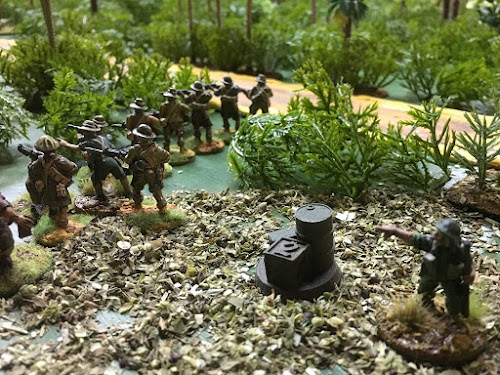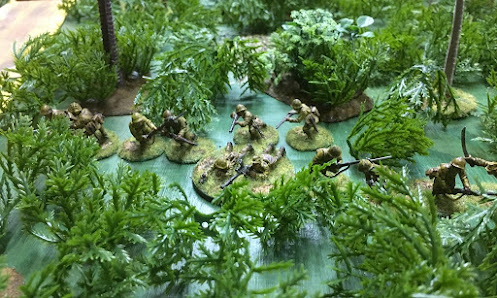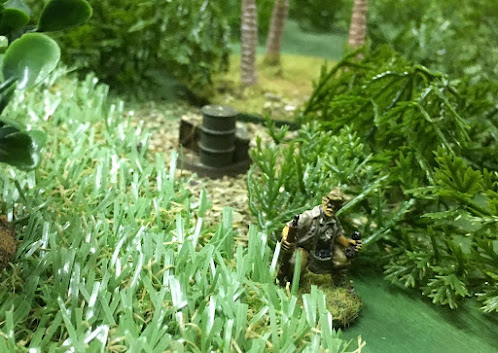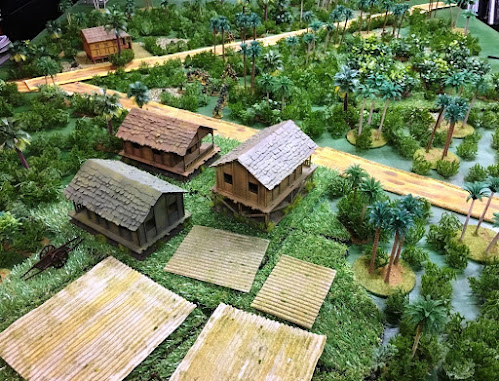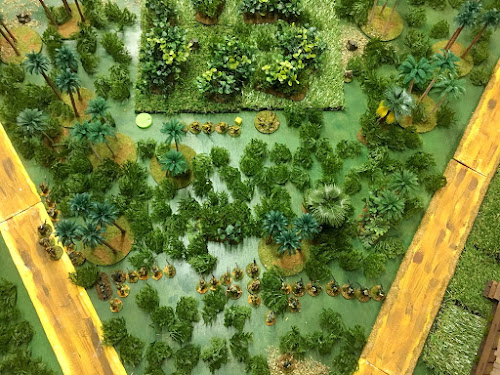The sixth battle in the exciting Malaya 1942 campaign using Chain of Command. Fought between Leith and John using the campaign written by Len Tracey.
After a slow start, the Japanese had finally forced the Australians from map 2, in their goal of reaching Singapore quickly.
 |
| Japanese Type 95 Ha-Gō light tank |
JAPANESE 4th PLATOON
The Japanese platoon of Rikugun Yamada pushed forward to wrest control of the main road junction near Yong Peng from the Australians.
- The 4th platoon was led by Rikugun (Lieutenant) Yamada, who is feeling secure after his victory against the Australians. His commanding officer’s opinion is +1, but the men’s opinion was -2 due to the high casualties experienced in the campaign so far.
- He was ably assisted by Gunsō (Sergeant) Baba, a keen 23-year-old who was the fourth son of a shopkeeper from Tokyo.
- Rifle squad 1 was led by 29-year-old Gocho (Corporal) Sakakibara, a stone worker from Tadami.
- Rifle squad 2 was led by Gocho (Corporal) Miyazawa, a 25-year-old farmer from near Myoko.
- Rifle squad 3 was led by the reliable Gocho (Corporal) Jinnai of Takamatsu.
- Grenade discharger squad was led by the 30-year-old Gocho (Corporal) Kadokawa.
- From the core Japanese platoon, 4 missed this battle while they were recovering. 8 new faces had been drafted in from other platoons to cover the recent campaign losses. Yamada-san decided to have all 4 missing from the grenade discharger squad.
AUSTRALIAN 1st PLATOON
Young Lieutenant Kenneth Reid’s platoon had delayed the Japanese vanguard but were being pushed back towards Singapore.
- The CO’s opinion of Lt. Reid was +4. He was feeling Superior. Perhaps he was starting to be overconfident? The men's opinion was good at +2 because of the delays they were inflicting.
- Sergeant Gary Turner again provided experience for the troops.
- Corporal Brian Evans usually led 1st section but was recovering from concussion. He was replaced by William “Billy” Brewer, who had stood in for him at an earlier battle and was now respected by the men.
- Corporal Colin Moore continued to lead the 2nd section
- Corporal William Colling continued to lead the 3rd section.
- Some replacements had finally arrived from Singapore. Enough to bring the platoon back to full strength, although they were 3 men short for this battle. Two were at the first aid station. The other was the gap left by the temporary promotion of “Billy” Brewer. Reid decided to drop a man from each section for this battle.
MAP
This was the first battle on map 3, using scenario 3 from the Chain of Command rulebook. The map was the Y-intersection of the main and secondary roads near the village of Yong Peng. (
In reality it may have been a large town in 1940. If so, just assume the main part of the town is just to the east of the tabletop).
3 random rolls on the campaign terrain table created the following map after random rolls for placement. A village and open area nearby made the eastern part of the table good a good defensive area. The secondary jungle in the north would cramp the attacker’s deployment; although could provide some flank protection if needed.
A compulsory building was to be added. We decided it made sense to have one near the junction to welcome weary travelers and so Latipah's Tea House came into being.
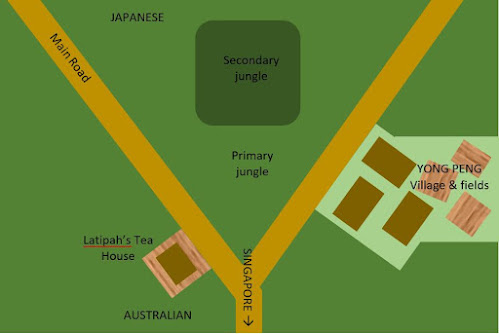 |
| Map for battle 6 - The Battle of Yong Peng |
SUPPORT
Leith rolled a 7 for support, which meant the Australians got the same (3 for platoon difference, +1 from CO’s opinion and +3 from half Leith’s roll – rounded down). Support choices were kept secret.
Possibly more Japanese tanks? I agonised over this. 8 support points would have been ideal for the Australians as that would allow a 2-pdr anti-tank gun and either an additional infantry section or a Vickers MMG to cover many possibilities. The really good supports for the Australians all cost 4 points, so 7 support points made it guesswork.
An interesting thought was to take a roadblock for each road and put them up near the Japanese table edge, so they could deploy any tanks, but not move them further down the road. Or maybe I should guard my flank with one roadblock on the secondary road only. I finally decided to call up a 2-pdr anti-tank gun and bring back the Lanchester armoured car.
If there was a medium tank the Boys anti-tank rifle was probably not enough. If I could get rid of any tanks, then the Lanchester would add some nice firepower a little way into the jungle from the road. At only 3 support points the Lanchester is a great way to get an HMG and an MMG but would be restricted to the roads and villages in this scenario. If I could not get rid of any tanks, it would be too dangerous to bring on the Lanchester, but then I probably would have to withdraw anyway.
The Japanese decided on a Type 97 Chi-Ha medium tank and a Type 95 Ha-Gō light tank. This would give them opportunities to race down the road and provide some heavy fire support.
FORCE MORALE
Each side had a +1 adjustment to the die roll. The Japanese adjustment was due to the campaign and the Australians due to Lt. Reid’s outlook. Low rolls saw the Force Morale become the opposite of the last battle, with 9 for the Japanese and 8 for the Australians.
PATROL PHASE
The Japanese commander spread his patrol groups rather wide and had trouble pushing forward as fast as he wanted. The Australians moved up as quickly as they could to try and make the secondary jungle a problem for the Japanese deployment. They were reasonably successful in this as you can see in the resulting photo, although it was always likely that the battle would be fought in the western half of the board (the left of the photo).
The white circles show the position of the Japanese jump-off points and the blue circles the Australian.
 |
| Japanese and Australian jump-off points after the patrol phase |
BATTLE
No roadblocks to deploy this time. With the higher Force Morale, the Japanese began the battle for the junction. As per the “At the Sharp End” campaign supplement from the TooFatLardies the Australians chose to begin this scenario with a Chain of Command die and an emplacement.
Turn 1 Phase 1
- A useful starting command roll of 2, 3, 3, 5, 6 for the Japanese. Making their intentions plain, they brought on a Chi-Ha medium tank on the main road and a Ha-Gō light tank on the secondary road end.
- The Australians replied with 2, 3, 5, 5, 6 starting towards a new Chain of Command die. They brought on the 2-pdr and the Boys rifle teams against the light tank, hoping to concentrate and get rid of it quickly before going after the better armoured Chi-Ha. The Boys anti-tank rifle team had to deploy in the road behind an emplacement so they could also get to fire at the light tank.
- 1 nett hit from each added 2 shock to the tank, the main gun sight damaged for the battle and the driver not able to get the tank in gear for the next phase. A good start.
 |
| Japanese Type 97 Chi-Ha medium tank |
Turn 1 Phase 2
- A 4, 5, 5, 6, 6 meant all the Japanese could do was accumulate some Chain of Command points and have another go. One or two 3s would have been handy to remove shock from the light tank and fire back at the 2-pdr.
Turn 1 Phase 3
- 1, 1, 2, 2, 6 allowed the Japanese to start the tank attack. The main gun put a shock on the 2-pdr crew but the hull machine gun failed to cause a problem.
- The medium tank raced 14” down the road towards the junction.
- A 2, 4, 5, 5, 6 continued the accumulation of Chain of Command points for the Australians and allowed the 2-pdr to put 2 nett hits on the light tank. The main gun was knocked out, dropping the Japanese Force Morale by 1.
- Sergeant Turner removed a shock from the 2-pdr. Directing the fire of the anti-tank rifle allowed them to put another nett hit on the light tank, damaging the engine. It was taking a pounding but still hanging in there. At 3 total shock it was close to the crew deciding to bail out.
 |
| The Australian Boys anti-tank rifle team supported the 2-pdr against the tanks |
Turn 1 Phase 4
- With 1, 2, 2, 3, 6 the Japanese medium tank raced another 13” down the road. The first infantry appeared on the table with rifle squad 1 and 2 arriving.
- The Australians used 1, 2, 4, 5, 6 to fire at the light tank. They Boys rifle missed but the 2-pdr finished it off with 1 nett hit – causing the crew to bail out. Losing support upset the Japanese and they lost 2 from their Force Morale. It was now down to 6.
- Ineffective fire from the Japanese overall this phase. But with them starting to mass, was this the calm before the storm?
Turn 1 Phase 5
- Lots of 1s opened up many command combinations for the Japanese with 1, 1, 1, 3, 4.
- The Japanese 1st rifle squad tried to move quickly but only managed 3”.
- The medium tank crept forward 4” and shot at the Australian 1st section, although did no damage.
- Replying with a 1, 1, 4, 5, 6 Sergeant Turner moved the Boys rifle team and the key 2-pdr team west - to try and take up position to fire on the medium tank.
- The Australian 1st section only managed a 1” tactical move. They were not able to see any opponents yet.
 |
| Having destroyed the light tank, the 2-pdr now switches to the Chi-Ha |
Turn 1 Phase 6
- A command of 1, 3, 3, 5, 6 saw the Japanese 2nd rifle squad carefully move forward 3” although they also were just short of seeing any enemy.
- The medium tank killed one of the anti-tank gunners with HE although the hull machine gun failed.
- One of the grenade discharger teams fired to no effect.
- The Australians rolled a straight with 1, 2, 3, 4, 5. The 2-pdr just missed the tank. It would have hit it if I had remembered to use 2 command points from the Sergeant to add +1 to the 2D6 roll.
- The Boys rifle team dashed across the road to find a position where they could fire without being blocked by the crew of the anti-tank gun.
- “Billy” Brewer’s 1st section landed 7 hits on the Japanese 2nd squad – resulting in 1 kill.
- The 2nd section arrived to assist, but not being able to see any targets decided to go on overwatch.
 |
| The Australians can only just see the Japanese through the jungle, but it allows them to fire |
Turn 1 Phase 7
- The duel continued with the tank. The Japanese used 1, 1, 3, 5, 6 to fire both guns to good effect. They killed one of the Boys team and added a shock. One more and they would break. They also killed a gunner from the 2-pdr team and added a shock as well.
- The grenade discharger squad were not able to contribute any casualties.
- After Sergeant Turner removed a shock, the 2-pdr clanged a round off the Chi-Ha’s turret. This rattled the crew - adding a shock and forcing the tank to reverse 3”. The Australian command of 1, 2, 2, 4, 5 also allowed the Boys to move 4” away from the edge of the road. They were now too fragile to stay in sight of the tank.
- The 2nd section moved 6” forward, bringing the Japanese 2nd rifle squad into sight but their fire was ineffective.
- The 1st section must have moved more carefully, since their reduced fire resulted in 1 kill and 1 shock on the 2nd squad.
 |
| The Japanese 2nd rifle squad takes some punishment before shooting back |
Turn 1 Phase 8
- The battle was starting to settle into a bit of a pattern, although before the Japanese could use their 3, 3, 3, 3, 4 the Australians used a Chain of Command die to interrupt for another shot at the tank, since they saw this as their biggest threat. The 2-pdr added 1 more shock and pushed the tank back another 4”.
- The Japanese responded by removing a shock and returning fire with the main gun. The Australian gunners managed to avoid casualties from the hits.
- The Japanese 1st squad made good progress through the jungle with a 9” move.
- Their 3rd squad arrived. The 2nd squad removed a shock whilst their fire placed a shock on each rifle teams within the Australian 1st and 2nd sections.
- With all his troops now involved in the battle, Rikugun Yamada arrived to personally direct the knee mortars. Their fire also placed a shock on each of the same rifle teams.
- The reply from the Australians was a double phase coming from a command roll of 1, 3, 4, 6, 6.
- The 2-pdr failed to land a hit.
- The Australian 1st section moved tactically towards the Japanese 2nd squad. With a rapid surge forward of 6” they killed a man and wounded the newly arrived Rikugun Yamada. He lost a command point and this dropped the Japanese Force Morale to 5.
- The rifle team of the 2nd section added a shock to the Japanese.
 |
| Latipah's Tea House at the junction with Yong Peng in the background |
Turn 1 Phase 9
- Continuing with 1, 2, 3, 5, 6 the anti-tank gun hit this time. The 0 nett hits provided no benefit to the Australians.
- Combined fire from the 1st and 2nd sections inflicted 2 kills and 3 more shock on Miyazawa’s squad. The 9 men left now had 4 shock in total. The large size of the squad meant that the Japanese could absorb a lot of punishment.
- The Japanese completed a Chain of Command die with a 1, 1, 3, 5, 6. A shock was removed but this failed to help the inaccurate fire from Miyazawa’s squad, even with them not counting the first 2 shock (a special campaign rule for the Japanese).
- The knee mortars finally hit something, adding a shock to each of the teams forming the Australian 2nd section.
Turn 1 Phase 10
- More fire and movement from the Australian left flank with 2, 3, 3, 4, 5 for command. The 2nd section tactically moved forward 2” although failing to inflict any damage. I rarely seem to inflict casualties from the half fire when moving tactically. At least the more limited movement kept the two sections together so that they could share casualties. Also, there is a real risk of rolling a high move on 2D6 that might put you into close combat range before you are ready.
- In Chain of Command movement distance is by dice rolls. You can designate a place to move to where there is obvious terrain, such “move up to the edge of the wood but do not go into the open”, “stop at the edge of the road”, “move to that barn”, “move up the road until you are level with the church”. Then even if you roll higher you can stop your movement there. What you cannot do is say “move to that blade of grass in the open field”, “move 6” along the road” or “stop 4.2” from the enemy” as it is not realistic for troops to be that precise. This adds to the fun as you may have to cope with troops ending up a little out of position where there are no clear landmarks.
- Whilst the 2nd section was moving, the 1st section laid down some effective fire – adding a shock as well as knocking out the injured Rikugun Yamada. His bravery had been inspiring his men but putting him in harm’s way. Japanese Force Morale was now down to 4 which meant Leith would only roll 4 command dice.
- The Chi-Ha had nothing to worry about as the AP round from the 2-pdr went wide, slamming into a tree. The 3rd Australian section of Corporal William Colling arrived to protect the anti-tank gun from the approaching Japanese of Gocho Sakakibara.
- Leith used a Chain of Command die to end the turn so that the brave Yamada-san regained consciousness.
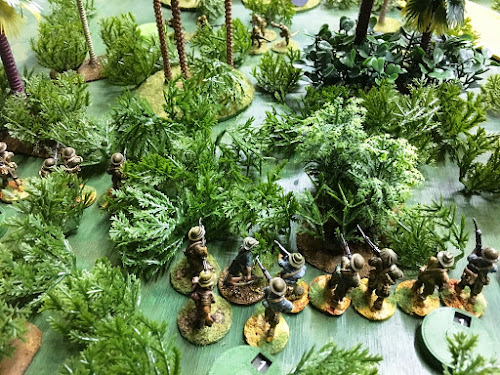 |
| Alternate fire and movement brings the Australians closer to the Japanese rifles |
Turn 2 Phase 1
- Despite only having 4 command dice, the Japanese roll of 3, 3, 4, 6 seemed quite useful. The Japanese plan was now to try and inflict casualties on the Australians to make the next battle easier. Unfortunately, the heavy fire from the 2nd squad and the grenade discharger squad inflicted no casualties on the western side of the battlefield.
- As the tank was about to fire on the 2-pdr, the latter used a Chain of Command die to interrupt with a quick shot for 2 nett hits. No shock added, but the main gun was knocked out of action. Resigned to whatever fate had in store for them, this did not to dampen the morale of the Japanese. Resorting to the hull machine gun failed to harm the Australian gun crew while the main turret was rotated to face its machine gun forward.
- Fire in the east killed a newly arrived rifleman from Colling’s 3rd section.
- A 1, 3, 3, 4, 5 brought the Australian’s just 1 off another Chain of Command die as the Boys rifle team continued to make their way back to safety. In some games you rarely see a Chain of Command dice but in this one both sides had the benefit of several.
- Despite missing the tank, the Australian small arms fire was more effective - adding 4 shock to the approaching squad of Gocho Sakakibara. The continual punishment of Gocho Miyazawa’s squad from the two Australian sections whittled it down to 8 men with 6 shock.
Turn 2 Phase 2
- With a 3, 3, 5, 5 Gocho Sakakibara ordered his 1st rifle squad to charge the Australians screening the anti-tank gun after removing a shock. Unfortunately, as they moved with purpose they fell short of engaging the Australians. Rolling 5 on 2D6 had brought the Japanese 4” short of engaging the Australians in close combat.
- A shock on the 2-pdr from the hull machine gun of the Chi-Ha, but no effect from the turret.
- Sergeant Turner removed a shock from the anti-tank gun. Knowing they had the next phase with a 2, 3, 4, 6, 6 he instructed the crew not to rush. Taking deliberate aim they responded to his short but inspirational speed – “just make sure you hit the bastard” - by smashing the tank with 4 nett hits. As the crew bailed out of the useless hulk the Japanese Force morale dropped to 3.
- Australian small arms fire killed 1 and added 1 shock to the charging 1st rifle squad, which would probably not be enough to stop them.
- The Japanese 2nd squad copped more fire. They were now down to 7 men with 9 shock (counting as 7 for the Japanese). Almost pinned. Remember in this campaign the Japanese take shock normally but discount 2 shock when determining its effect.
 |
| The Japanese crew managed to bail out of the knocked-out Chi-Ha medium tank |
Turn 2 Phase 3
- A 1, 1, 2, 2, 3 for the Australian consecutive phase allowed plenty of command combinations.
- With the tank threat eliminated, the Lanchester rattled up the road, veering left up the main road. They were hoping to pour fire into Gocho Sakakibara’s advancing squad but unfortunately did not make it far enough.
- To the west the continued fire of the Australian 2nd section brought the dwindling Japanese squad down to 6 men with 12 shock (counting as 10), nearly breaking them. Seeing this, Acting Corporal “Billy” Brewer charged his men forward.
 |
| The Australian 1st section charges home against the pinned Japanese 2nd squad |
- The advantage definitely favoured the Australians, although the Japanese put up stiff resistance. As the already wounded Rikugun Yamada unsheathed his katana to help, the Japanese ended with more dice than Leith or I expected.
- For the Japanese: 5 dice from 5 men, +2 dice from the junior leader, +2 dice from the injured senior leader, +2 dice from the Australians using 2D6 to move into range, -5 dice for the 12 shock (counting as 10), +2 dice for being aggressive (1 per 3 men), +4 dice for the LMG gave 12 dice so far. Adding 1 dice per 2 for defending heavy cover, then halving because of being pinned, resulted in a total of 9 dice.
- For the Australians: 8 dice from 8 men, +2 dice from the junior leader, +2 dice from the Thompson SMG, +2 dice for the Bren resulted in a total of 14 dice. Normally LMGs do not give the attacker extra dice, but we decided that the magazine-fed Bren would be similar to the Japanese LMG in that it can be treated as an SMG in attack. See the Japan Island Defence platoon list for details. There are plenty of accounts of the Bren being used in this manner, particularly by the Australians in the Pacific.
- The ensuing melee resulted in 3 shock to the Japanese squad, all 5 men killed, and Gocho Miyazawa losing a command point. This wounding was a bad thing for the Japanese, bringing their Force Morale down to 2. However, they seemed unconcerned by the destruction of the squad! Leith rolled a 1 which is adjusted to 0 in this campaign for the Japanese. Despite being heavily involved in the fighting, Rikugun Yamada avoided further wounds.
- Only the two Japanese leaders remained. They withdrew 12” while working out what to do next.
- “Billy” Brewer was knocked out while leading his men although this did not impact their morale. The Australians lost 2 rank and file killed. Moving forward to take the position now brought them in close range of the Japanese grenade discharger squad.
 |
| The Australians have wiped out the Japanese 2nd squad, with only the leaders surviving. The leaders have retreated behind the grenade discharger squad which the Australians now have firmly in their sights |
Turn 2 Phase 3
- Despite only 3 command dice, the Japanese rolled enough with 2, 2, 4. With the focus turning east of the main road the knee mortars laid some preliminary bombardment; killing a Bren loader and adding the first shock to Corporal William Colling’s rifle team.
- The squad knew what Gocho Sakakibara wanted. They advanced 5” into close combat range through the jungle. No chance of getting lost as they were within sight of the main road.
- Oops, we forgot to reduce the Japanese movement by 2” because of the 4 shock (treated as 2). This would have left the Japanese squad just 1” short of engaging in close combat. We let it stand as the Australians had used +4 dice instead of +2 for the Bren in the other combat – swings and roundabouts.
- With just one point short of a full Chain of Command die, the Lanchester was unable to interrupt the Japanese squad’s advance.
 |
| The Australians are winning west of the road as the Japanese advance to the east |
- A vigorous battle occurred between the aggressive Japanese and the stubborn Australians.
- For the Australians: 6 dice from 6 men, +2 dice from Corporal Colling, +2 dice from the Japanese using 2D6 to move into range, +2 dice from the Thompson SMG, +4 dice for the Bren gave 16 dice so far. Adding 1 dice per 2 for defending heavy cover resulted in a total of 24 dice.
- For the Japanese: 12 dice from 12 men, +2 dice from Gocho Sakakibara, -1 dice for the 4 shock (counting as 2 shock for the Japanese in this campaign), +4 dice for being aggressive (1 per 3 men) +2 dice for the Japanese LMG counting as an SMG in attack (see the Japan Island Defence platoon list for details) result in a total of 19 dice.
- Not even the jungle could shield all the men as they tried to dodge the dice with their names on them. The Japanese received 3 shock as 5 men and Gocho Sakakibara were killed. The loss of his leadership affected the Japanese force greatly. Their Force Morale bottomed out, causing the remnants of the platoon to withdraw from the field.
- In the melee they had put out of action 4 Australians from the 3rd section. Corporal Colling had been wounded, which dropped the Australian Force Morale to 7. Both teams only had 1 man left standing. With the help of the Bren gunner and the Thompson gunner, Corporal Colling searched among the fallen for any men in need of medical attention.
 |
| The Lanchester armoured car rattles past Latipah's Tea House, but is not allowed to stop |
WRAP UP
The Australians were relieved that the battle ended when it did. Because the Japanese count as aggressive they do not retreat from melee with a nett hit difference of only 1. If the Force Morale had not dropped to 0 there would have been a second round of combat and a chance to wipe out the section and/or kill the leader. Although likely that the Japanese squad would have ended pinned, any additional casualties for the Australians would have hurt them in the campaign.
- For the Australians: 2 dice from 2 men, +1 die from Corporal Colling, +2 dice from the Thompson SMG, +2 dice for the Bren would give them 7 dice.
- For the Japanese: 7 dice from 7 men, -2 dice for the 7 shock (counting as 5), +2 dice for being aggressive (1 per 3 men) +2 dice for the Japanese LMG would give them 9 dice.
The Australians would have been better off using 2D6 instead of 1D6 to move the Lanchester. Wheeled vehicles double their movement on the road, so this should have moved them close enough to fire the turret HMG for 10 dice at Sakakibara’s squad, with them counting only as being in light cover. Additional kills and shock would have reduced their dice but more importantly reduced their move enough to not make it into contact (
if we had remembered!).
The low starting Force Morale meant that both sides were brittle. Early setbacks to the Japanese Force Morale from damage to the tanks and wounds to various leaders did not help the Japanese cause. Their Force Morale dropped steadily throughout the game, even though they were not losing that many men killed.
On the western side of the battlefield, the Australians were able to dominate with 2 sections against 1 squad.
The 3rd Japanese rifle squad was too far back to be a threat. The Japanese never seemed to have the spare command to push it forward, particularly early on. I think this was mainly due to the 2 tanks chewing up most of the 3s.
Given how weak the armour is on the Ha-Gō light tank it turned out to be a liability; both from using up command dice and also from contributing to the loss of Force Morale. Mind you, this was only because the Australians chose the 2-pdr anti-tank gun for support. Had they not, it would have been a very different battle. It was certainly threatening having a tank coming down each road.
It would also have been much scarier for the Australians if the Japanese had obtained 1 more support point as this would have allowed them 2 medium tanks.
The choice of concentrating on taking out the weaker tank before turning on the medium tank worked well, despite taking longer than I had hoped.
Once again we enjoyed ourselves immensely. The more we play, the more we like Chain of Command as well as the campaign system.
 |
| The Japanese commence their withdrawal from the battlefield - but they will be back |
CAMPAIGN IMPACT
A major victory to the Australians. They can now counter-attack on this map if they wish – the first time in the campaign. That should be fun.
20 Japanese casualties in the battle of Yong Peng for the Japanese, including Gocho Sakakibara. The 2nd rifle squad was wiped out. Only their wounded Gocho was left, down to 1 command point.
Rikugun Yamada heads off to hospital and a severe interview with his commanding officer. His platoon probably will be used to provide replacements for other more successful ones.
The Australians had 10 casualties including 2 from the anti-tank support team. With a Force Morale difference of 7, they scoured the battlefield and patched up all but 3. We decided to approximately proportion these as it would be rather dodgy to take most losses from the supports. So, 1 “killed” from the 2-pdr team and 2 from the main platoon. The latter become 1 dead and 1 missing the next turn.
Since Corporal Brian Evans returns with 2 men, “Billy” Brewer will return to the ranks having gained further experience at leading a section. The lucky Australian platoon will only be 2 short: Private Martin Bowen dead and Private Joseph Pentram headed for the aid station. It could have been much worse.
The CO’s opinion of Lt. Kenneth Reid rose to +5. The men’s opinion leapt to +4. His own outlook went to heroic. Had the Australian press found a new hero amongst the debacle of the Malayan campaign? The next few battles would decide.
